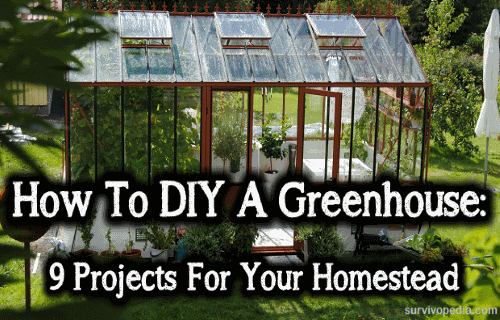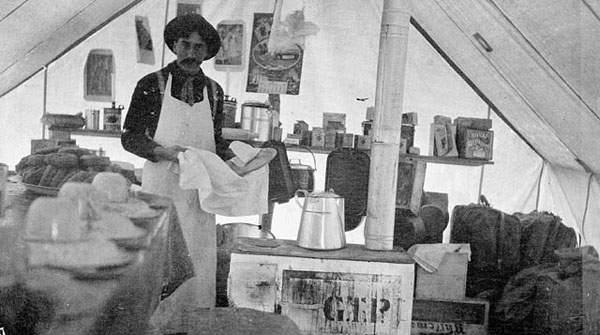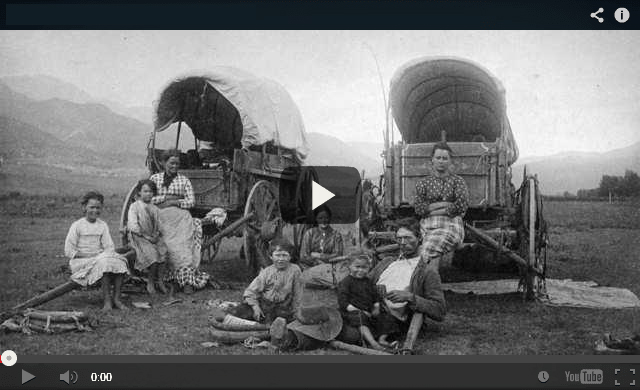Today’s article is as green as it gets, because it’s about DIY-ing greenhouses. How do you build a greenhouse, you ask? The easy answer is: you build a house and you paint it green.
Ok, I am kidding, but today’s article is about the basics of DIY-ing your own-personal greenhouse, the types you can build, tips and tricks, and what to beware of. You know, the whole 9 yards in DIY for the self-conscious prepper.
The first question to answer is: why do you need a greenhouse?
Well, maybe because gardening is a very rewarding hobby, especially when it comes to building your survival garden for when SHTF. And, it’s also a very relaxing one (hobby, that is), combining something very useful with lots of fun in the process.
So, if you’re that kind of prepper who tries to be as independent as humanly possible, today’s article will fit you like a glove.
If you seek to get off the grid, a greenhouse will definitely help you in your endeavor. I mean, growing your own food is more than rewarding; it’s the definition of survival. And growing your own food in a greenhouse means that even cold weather is not a problem.
Plant life and veggies are particularly sensitive when it comes to harsh weather, but a greenhouse is very effective in mitigating that problem. Moreover, when it comes to a do-it-yourself job, a greenhouse is the perfect solution, both in terms of complexity and costs.
So, let’s talk a little bit about greenhouses, or, better, about how to DIY them. There’s an inside joke about this type of projects: a DIY project will cost you twice as much, it will look half as good and it will take twice as long as you initially anticipated. The time part may be right, but if you follow the directions well, the cost and appearance parts are rubbish! Well, it will cost you a bit, but not nearly as much as if you paid somebody to come and build you one.
Hence, brace yourself, because DIY-ing a greenhouse is not exactly a child’s play, but the end result will be awesome.
When it comes to building stuff, first you must define the terms: what’s a greenhouse after all?
Simply put, a greenhouse is a type of structure which creates an ideal micro-climate for plant life to grow and develop, so it can be used to start plants such as veggies or to grow them from seed to…well, the end.
The first thing to contemplate is the location of your desired greenhouse. For optimum results, you must choose a south-facing area which will provide your greenhouse with good, consistent sunlight. Remember that all structures around must be to the north of your greenhouse.
You should opt for locations which offer morning light vs afternoon sun; however, ideally speaking, an all-day-long sun would be the best, as it will lead to better yields and it will speed up the growth of the plants.
Also, pay attention to nearby structures (like your house), trees and bushes and make sure they do not cast a shadow on your greenhouse. It would be wise to choose a spot that has easy access to electricity, as most greenhouses require some ventilation and sometimes additional heat for maintaining an optimal temperature inside, especially in very harsh climates.
Look for a well-drained area and remember that you must siphon away excess rain water, but the best thing would be to design your greenhouse foundation in such way as it would encourage drainage naturally.
With the location issues taken care of, let’s move on with our DIY journey.
Let’s begin with the basics: what type of greenhouse should you build?
It all depends upon several factors, including the geographical area you live in terrain, humidity, climate, and temperature. All these issues must be addressed. For example, if you’re living in a county with million-mile-per-hour winds, especially in the winter and in the spring, well, that means you’ll have to use a sturdy design in order for your greenhouse project to last and withstand those pesky winds.
Check out this self-explanatory video for further info about what type of greenhouse to build.
Video first seen on Bigelow Brook Farm (Web4Deb)
Another issue is the budget: how much money do you intend to spend on your DIY project? And here are a couple more questions: how big do you want your greenhouse to be? What do you want to grow inside your greenhouse? All these elements come into play and you must figure them out before you start building a greenhouse.
Note that any garden lacking a greenhouse is in fact incomplete, as a well-built and well-designed greenhouse will help you with planting fall and winter crops, thus extending the growing season by almost 100%, not to mention that you can grow produce all year long right in your backyard.
Now, let’s take a look at a few budget-friendly greenhouse building plans. None of these are really expensive and all are fairly easy to build with simple tools and moderate skills.
1. The Barn Greenhouse
If you’re not exactly a master DIY-er, you should start with a smaller project; something like a mini greenhouse. In this case, the barn greenhouse would suit you perfectly. The wall framing can be cut from wood-boards if you have them available on your property. If not, you can simply buy them from a hardware store for just a few bucks.
The side paneling can be built from roofing tin and you can trim the corners of the panels by metal flashing. This model of greenhouse is covered with corrugated roofing. For the detailed plans just follow the link in the photo source.
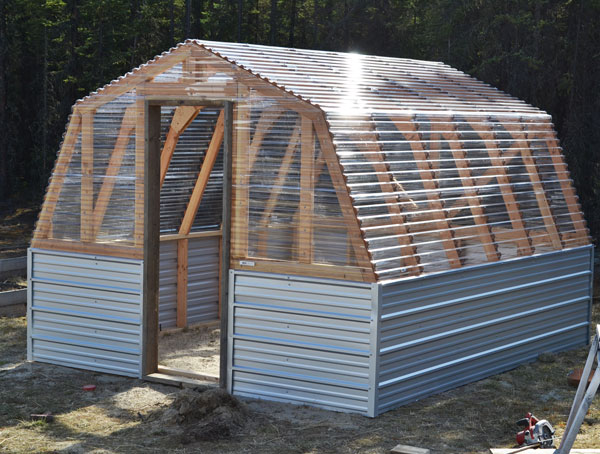
Photo source: Ana White
2. Lumber Frame Greenhouse
As the title says, the lumber frame greenhouse is basically an eight foot tall structure that’s very light and easy to incorporate into your garden. The frame is nailed together and you can fix it with stakes.
It’s built using a lumber frame for the skeleton, window frames for proper ventilation and a door. All the materials can be recycled from old stuff laying around your property or picked up from junk sales. For detailed plans, just go to the link from the photo source.
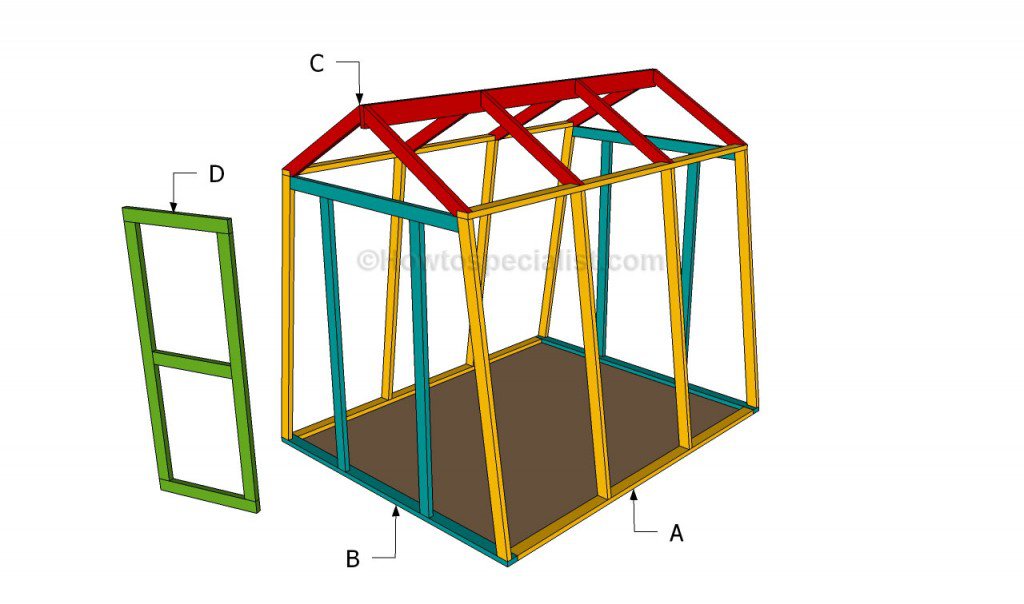
Photo source: How To Specialist
3. The Hoop Style Greenhouse
This project requires wood for the foundation and PCV pipes and rebar for the structure; the amount of material depends upon the desired area you want to cover. The hoop stand is made using rebar and then the PVC pipes are fixed on the hoop stands.
After the wood/PCV structure is built, you can cover it with plastic sheeting and attach the cover to the skeleton using a lathe. In the end, you can add a simple wood frame and a door to your greenhouse, and that’s about it. See the photo source for detailed plans.
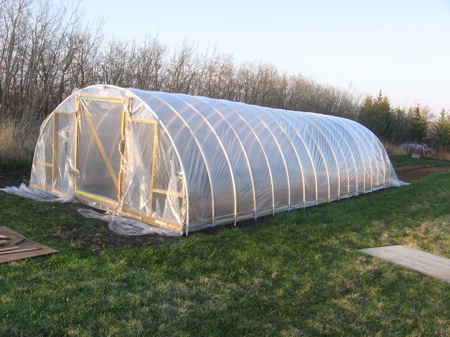
Photo source: Alberta Home Gardening
4. The Fifty Dollar Greenhouse
As you will see for yourself, you can DIY a greenhouse for just $50, in a hoop-like greenhouse design. This is a hugely popular design, very similar to the hoop-style one, and you’ll end up getting a tunnel type greenhouse, ideal for confined spaces.
The basic frame can be built using lumber and for covering the top, clear plastic sheet is the best and the cheapest. On the sides of the wooden structures you can attach PVC pipes for enhancing rigidity and maintaining the shape of the hoop. For detailed plans, go to the link in photo source.
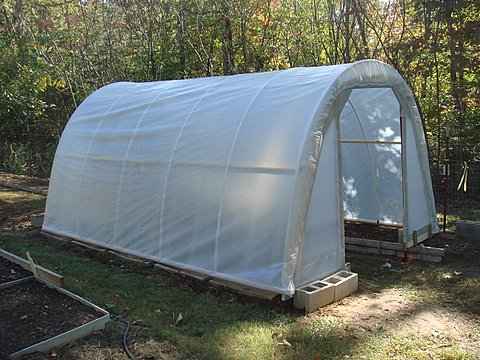
Photo source: Door Garden
5. The Dome-Shaped Greenhouse
This DIY project is aimed at art lovers, as this structure built from broken triangles looks absolutely beautiful. The detailed plans in the photo source, but keep in mind that this is a tougher project, requiring proper measurement and a well-thought plan for achieving that beautiful dome-look. Assembling it will take some time and after building the wooden structure, you can cover it with special greenhouse sheeting, available at hardware stores.
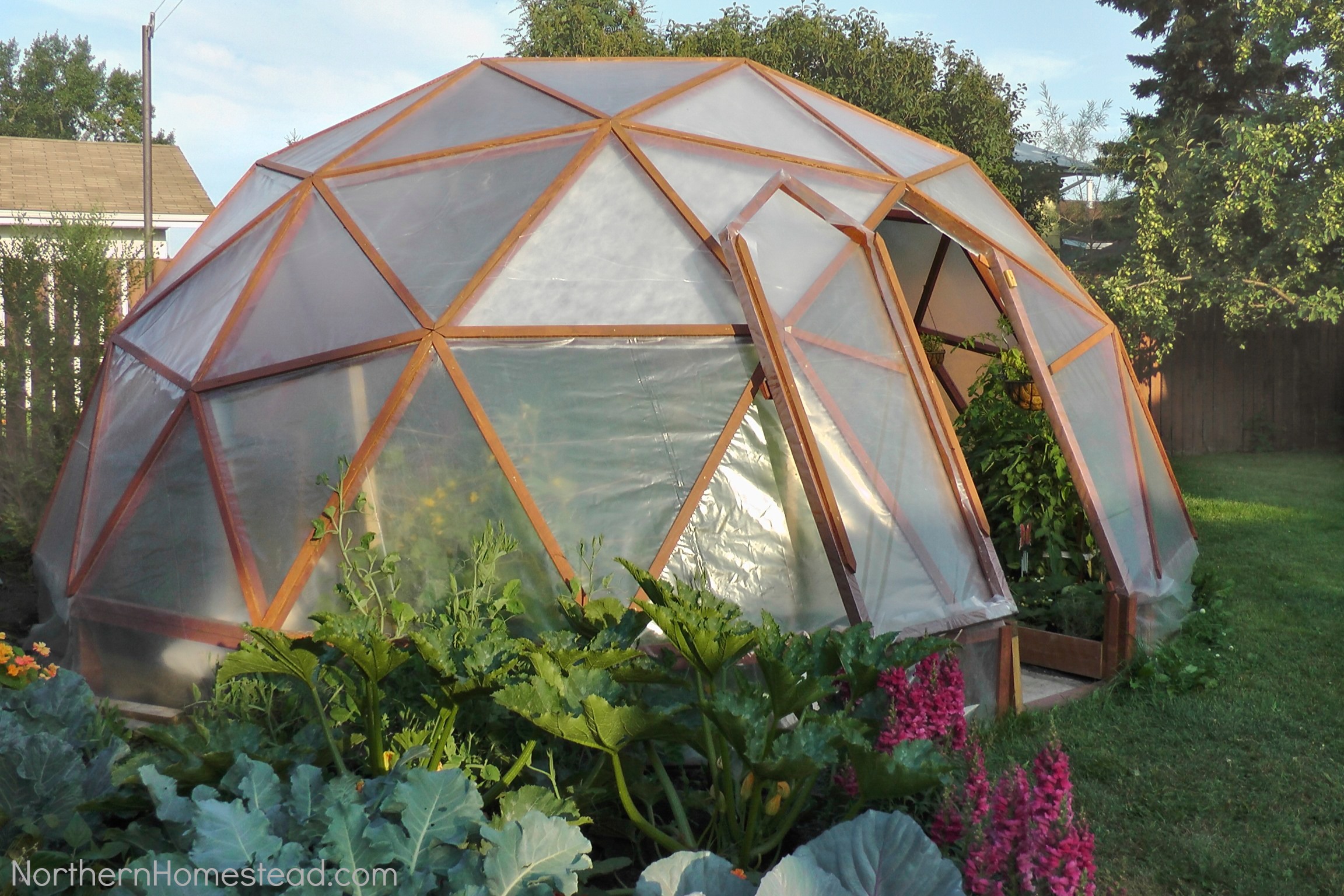
Photo source: Northern Homestead
6. The Scrap Window Greenhouse
As the title suggests, this DIY project will make the most of your old and, until now, useless window frames that are lying in your attic or wherever. Basically, you’ll have to build the foundation from wood and use screws to assemble the recycled window frames on it. You can finish the mix with some tin roofing. You’ll find the lots of ideas in the photo source.
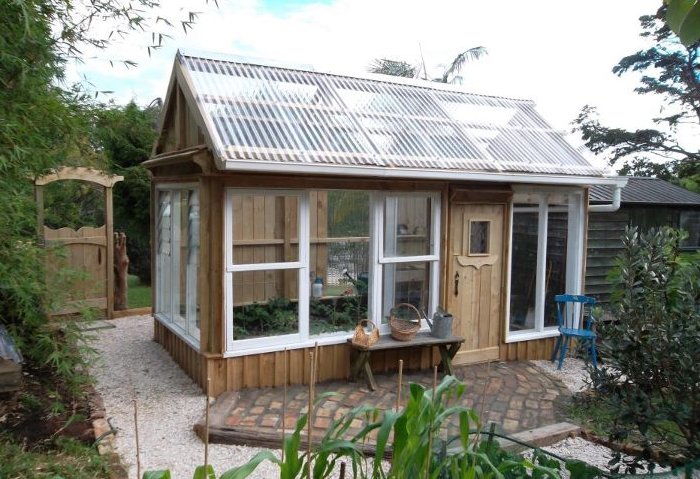
Photo source: Inspiration Green
7. The Scrap Door Greenhouse
This is a variation on the previous project, this time using scrap doors instead of windows. If you have enough old doors laying around in your junkyard, now is the perfect time to recycle them and make the most out of them. This is a very simple project, with scrap doors used instead of side paneling, with plastic sheets or tin roofing put into the mix for additional awesomeness! See photo source for more DIY details.

Photo source: Mother Earth News
8. The Plastic Bottle Greenhouse
This project is perfect if you’re obsessed with recycling plastic bottles, as it requires hundreds of them, and you’ll save the environment in the process. The structure is very simple, made from wood, with the plastic bottles inserted in between, acting like a transparent wall. This is a recycler’s fantasy for getting the greenhouse of your dreams. This DIY project is perfect for small places and it is very friendly on the budget. Here’s a video detailing the how to’s.
Video first seen on: Wild Urban
9. The Sturdy Greenhouse
If you live in high wind and/or snowy areas, here’s a video detailing the proper DIY greenhouse project for you. These are built to be sturdy, which supports strong winds and heavy snow loads.
Video first seen on LDSPrepper
I hope the article helped and if you have suggestions or comments, feel free to express yourself in the dedicated section below.
And stay tuned if you want to learn more on this topic as tomorrow we are going to discuss the best techniques to heat your greenhouse!
Discover how to survive: Most complete survival tactics, tips, skills and ideas like how to make pemmican, snow shoes, knives, soap, beer, smoke houses, bullets, survival bread, water wheels, herbal poultices, Indian round houses, root cellars, primitive navigation, and much more at: The Lost Ways
The Lost Ways is a far-reaching book with chapters ranging from simple things like making tasty bark-bread-like people did when there was no food-to building a traditional backyard smokehouse… and many, many, many more!
Here’s just a glimpse of what you’ll find in The Lost Ways:
From Ruff Simons, an old west history expert and former deputy, you’ll learn the techniques and methods used by the wise sheriffs from the frontiers to defend an entire village despite being outnumbered and outgunned by gangs of robbers and bandits, and how you can use their wisdom to defend your home against looters when you’ll be surrounded.
Native American ERIK BAINBRIDGE – who took part in the reconstruction of the native village of Kule Loklo in California, will show you how Native Americans build the subterranean roundhouse, an underground house that today will serve you as a storm shelter, a perfectly camouflaged hideout, or a bunker. It can easily shelter three to four families, so how will you feel if, when all hell breaks loose, you’ll be able to call all your loved ones and offer them guidance and shelter? Besides that, the subterranean roundhouse makes an awesome root cellar where you can keep all your food and water reserves year-round.
From Shannon Azares you’ll learn how sailors from the XVII century preserved water in their ships for months on end, even years and how you can use this method to preserve clean water for your family cost-free.
Mike Searson – who is a Firearm and Old West history expert – will show you what to do when there is no more ammo to be had, how people who wandered the West managed to hunt eight deer with six bullets, and why their supply of ammo never ran out. Remember the panic buying in the first half of 2013? That was nothing compared to what’s going to precede the collapse.
From Susan Morrow, an ex-science teacher and chemist, you’ll master “The Art of Poultice.” She says, “If you really explore the ingredients from which our forefathers made poultices, you’ll be totally surprised by the similarities with modern medicines.” Well…how would you feel in a crisis to be the only one from the group knowledgeable about this lost skill? When there are no more antibiotics, people will turn to you to save their ill children’s lives.
If you liked our video tutorial on how to make Pemmican, then you’ll love this: I will show you how to make another superfood that our troops were using in the Independence war, and even George Washington ate on several occasions. This food never goes bad. And I’m not talking about honey or vinegar. I’m talking about real food! The awesome part is that you can make this food in just 10 minutes and I’m pretty sure that you already have the ingredients in your house right now.
Really, this is all just a peek.
The Lost Ways is a far–reaching book with chapters ranging from simple things like making tasty bark-bread-like people did when there was no food-to building a traditional backyard smokehouse… and many, many, many more!
And believe it or not, this is not all…
Table Of Contents:
The Most Important Thing
Making Your Own Beverages: Beer to Stronger Stuff
Ginger Beer: Making Soda the Old Fashioned Way
How North American Indians and Early Pioneers Made Pemmican
Spycraft: Military Correspondence During The 1700’s to 1900’s
Wild West Guns for SHTF and a Guide to Rolling Your Own Ammo
How Our Forefathers Built Their Sawmills, Grain Mills,and Stamping Mills
How Our Ancestors Made Herbal Poultice to Heal Their Wounds
What Our Ancestors Were Foraging For? or How to Wildcraft Your Table
How Our Ancestors Navigated Without Using a GPS System
How Our Forefathers Made Knives
How Our Forefathers Made Snow shoes for Survival
How North California Native Americans Built Their Semi-subterranean Roundhouses
Our Ancestors’Guide to Root Cellars
Good Old Fashioned Cooking on an Open Flame
Learning from Our Ancestors How to Preserve Water
Learning from Our Ancestors How to Take Care of Our Hygiene When There Isn’t Anything to Buy
How and Why I Prefer to Make Soap with Modern Ingredients
Temporarily Installing a Wood-Burning Stove during Emergencies
Making Traditional and Survival Bark Bread…….
Trapping in Winter for Beaver and Muskrat Just like Our Forefathers Did
How to Make a Smokehouse and Smoke Fish
Survival Lessons From The Donner Party
Books can be your best pre-collapse investment.
The Lost Ways (Learn the long forgotten secrets that helped our forefathers survive famines,wars,economic crisis and anything else life threw at them)
Survival MD (Best Post Collapse First Aid Survival Guide Ever)
Conquering the coming collapse (Financial advice and preparedness )
Liberty Generator (Build and make your own energy source)
Backyard Liberty (Easy and cheap DIY Aquaponic system to grow your organic and living food bank)
Bullet Proof Home (A Prepper’s Guide in Safeguarding a Home )
Family Self Defense (Best Self Defense Strategies For You And Your Family)
Survive Any Crisis (Best Items To Hoard For A Long Term Crisis)
Survive The End Days (Biggest Cover Up Of Our President)
Drought USA (Discover The Amazing Device That Turns Air Into Water)
About Chris Black
Chris Black is a born and bred survivalist. He used to work as a contractor for an intelligence service but now he is retired and living off the grid, as humanly possible. An internet addict and a gun enthusiast, a libertarian with a soft spot for the bill of rights and the Constitution, a free market idealist, he doesn’t seem very well adjusted for the modern world. You can send Chris a message at editor [at] survivopedia.com.

